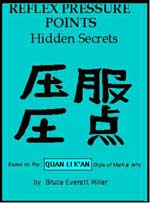I've long heard "one strike one kill" for martial arts. The question is - do you get to do your killing strike as your only movement? Since we're stuck using Japanese terms to explore the historical principles of Okinawan arts I'd like to chat a little about the idea of "atemi" and "todome." A concept in fighting recently brought to my attention.
Here's what google had to offer:
http://www.ao-denkou-kai.org/new_page_11.htm
http://pages.prodigy.net/david_wolfe/pm ... rms_T.htmlTechniques...will exemplify a variety of different principles, which demonstrate the difference between "atemi waza" (striking techniques) and "todome waza" (finishing blow techniques).
http://pages.prodigy.net/david_wolfe/pm ... rms_A.htmlTodome-no ichigeki is a term used to mean a finishing sword cup, i.e., a coup de grace.
http://aikidojournal.com/new/index.php?id=74Atemi, , means striking the body. They are the traditional striking technques aimed to a vital point on the opponent's body.
That last one from the Akido gentleman is my favorite. It says that we don't always start out with access to a killing blow that sometimes that access needs to be created by "disruption of postural integrity". The contemporary military terminology of Shock and Awe comes to mind as another metaphore.There are kicks and strikes, but most are of the todome variety - finishing off a downed enemy or classic atemi - disruption of postural integrity so as to effect a killing method.
So are there Uechi kata/drills/techniques that lend themselves to this idea and are there techniques that don't.
I think this is particularly important to women who train because of who we'll generally face in a self-defense situation. And it also sets up a certain mindset - you know you're doing certain techqnies not to stop the fight but to disrupt your bad guy to the point where you can do the kinds of techniques that will end the fight.
This connects with a couple of threads I've had earlier on hard-wired reactions. You spit in the face, they flinch. You grab for the scrotum, they'll use at least one hand to push you away or grab your grabbing arm while pulling the hips away from you. In looking at traditional kyusho there are techniques (like the ones where you rub your knuckles over the ears or under the nose) that won't ever knock anyone out - but they generate enough pain sensation to keep the bad guy from doing anything other than flinch away from you.
To me this is made somewhat manifest in the Uechi pattern of circle/something, circle/something, circle/something. And also in individual hajiki techniques like the eye rakes and the double hirkaen strikes.
So in Dan Kumite/Sanseiryu Bunkai - attacking the leg sets you up for the finishing technique of dumping them on their head.
The side snap kick in Kanshi kata breaks their balance at the knee to set you up for a variety of follow ups.
I don't buy into the idea that you can string 4, 5, or 6 of these things along and come up with guaranteed patterns. But I do like the idea of a few if/then tools in the toolbox.
Dana

